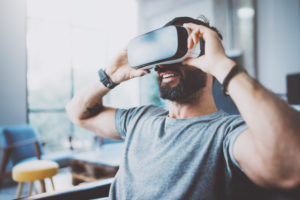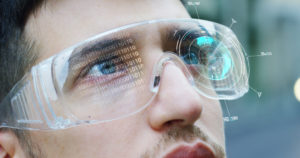

(thinkhubstudio/Shutterstock)
We’re on the cusp of major breakthroughs in the metaverse, that collective world of new augmented reality (AR) and virtual reality (VR) experiences that is gaining steam. The new meta modality will not only be a huge new source of user and behavioral data for enterprises, but it will be a fertile ground for deploying rapidly maturing AI technologies like NLP and computer vision.
AR and VR technologies have been simmering on the backburner for years. Up to this point, VR has primarily been used for immersive video games, although a few enterprise software companies have dabbled in AR and VR interfaces, including Looker before it was snapped up by Google Cloud.
But Facebook CEO Mark Zuckerberg put the collective worlds of AR and VR, i.e. the metaverse, firmly on the front burner last month when he announced Facebook was changing its name to Meta. The metaverse, it turns out, is a lot closer than many of us expected–perhaps as close as that sword in your Oculus-enabled hands.
This is great news for gamers, of course, but enterprises should also take notice, according to Dan Eckert, PwC’s resident AR and VR expert. “It’s getting significantly better,” he says. “There’s more users. There’s more interactivity. The environments are significantly more immersive.”
According to Eckert, the accelerated rollout is the result of a confluence of events. For starters, on the VR side (which is tracking ahead of AR) the technology for creating VR experiences has gotten significantly better in a short period of time.
“It used to take us six to nine months to build an interactive training simulation in VR. I’d have to have developers, and I have creatives and I would have artists and scriptwriters, and it was like producing a little movie or game,” Eckert says. “What used to take us nine months-plus I can now do in less than a week.”

Lots of progress has been made in VR headsets, or head mounted display (HMD), according to Dan Eckert, PwC’s resident AR and VR expert (SFIO CRACHO/Shutterstock)
The hardware has dramatically improved, too. Just a few years ago, a quality VR experience would have required a high performance gaming system, which would be tethered via a cable to the head mounted display (HMD). But today, users can pick up a quality, wireless HMDs for $200.
Lastly, the management tools have improved. “[Before] I pretty much need to go to MIT or Caltech to be able to keep it maintained and up to date,” Eckert says. “To manage 25 headsets, is not a big deal. But if I’m going to manage 2,500 or 5,000 or 10,000 or 80,000 headsets–now it goes into a wholly different world. I couldn’t do that a few years ago. I can do it now, and do it securely and do it cost effectively.”
Eckert sees enterprises adopting VR for training in the near future. PwC has purchased thousands of VR headsets and uses them to train PwC employees and clients. It uses VR headsets for sales meetings, even for traditional PwC services like auditing and consulting. It has even held a VR event for clients, which was very well received, he says.
“On the VR side, this is where we’re seeing an explosion, and it’s most of it is focused on training,” he says. “We did a study back in 2018 looking at the efficacy of using VR for training in the enterprise and the results were pretty spectacular. And they’ve only gotten better overtime because the cost create content is significantly dropping.”
The secret to VR’s success for training is deceptive simply, according to Eckert.
“In VR, you can’t multitask,” he says. “You’re completely enveloped in the environment. So what used to take us an hour to train in the classroom I can do in 20 minutes in VR because I’m not distracted. It’s it’s like a one-on-one coaching session to work on these soft skill training that we find is very beneficial.”
AR also has compelling use cases, such as providing field technicians diagrams through their mixed reality glasses. But mixed reality headsets are very nascent right now, which Eckert says will slow AR’s rollout.
“The technology is not ready for primetime, if you will–in my opinion, anyway,” he says. “I think it’s amazing for very specific use cases, but don’t plan on everyone wearing a headset to do their job over the next two or three years.”
As enterprises experiment with AR and VR, the applications for data and AI will be widespread. The data analytics and AI angles are nascent today, says Eckert, but the potential uses are significant.
Today, PwC is collecting positional information in its VR training session. “We have all the ability to collect everything around training, for example, how long did it take you to get through a specific section of the training?” he says. “Where did you stumble? How long did it take you to answer things? Did you articulate it correctly?”
The next generation of VR headsets will collect more user information, including detecting the stress level of the user, and even facial recognition. “We’re going to see more capabilities and really understanding the biometrics that are generated from an individual, and be able to use that to enhance the training experience,” he says.
That data collection will enable a feedback loop with the VR user. For example, if an enterprise is using VR to simulate a lineman repairing a high-voltage wire, the headset will be able to detect the anxiety level of the user. That information will inform the enterprise how to personalize the next set of VR lessons for the employee, Eckert says.
“Remember, you’re running nothing more than software on a digital device, but because it senses three dimensions, you can put input through gesture hand control, through how you gaze, where you gaze. It’s collecting data,” he says. “Now that data can then be acted upon to create that feedback loop. And that’s why I think it’s so important. In this immersive world that we have, that feedback …will make it even that much more realistic of an experience.”
AI will be a tremendous addition to the AR and VR experience, particularly with cognitive agents. PwC is already experimenting with its cognitive agent, called Astro, that installs on smartphones and guides PwC employees through corporate tasks. In the near future, these bots will function like avatars that guide VR users.
“If you’re in a situation where you’re being trained on something and you have a question, using natural language you can ask the question of the avatar as if they’re the instructor and they’ll communicate back to you information that will help you achieve the desired result,” Eckert says.
Many of the ingredients are already in place for a big surge in adoption of VR technologies. From the powerful wireless VR headsets and low-latency 5G networks, to development and management tools for the VR experience and NLP-based cognitive agents, the table is set for an explosion of VR use cases.
We lack just one element for AR to take flight in the real world in a big way. “What we’re missing are the glasses,” Eckert says. “The glasses aren’t there yet.”
Even if some company hits the sweet spot with a pair of capable and affordable AR glasses tomorrow, it will take some time, perhaps two to three years before it hits critical mass, says Eckert. “At CES they just announced contact lenses that can do this,” he says. “That capability is coming, and it’s almost in touching distance, but not quite yet.”
Related Items:
A Virtual Reality Lens for Big Data Visualization
Nvidia To Use Virtual Reality for Autonomous Vehicle Testing
4 Ways VR Will Change Big Data
April 26, 2024
- Google Announces $75M AI Opportunity Fund and New Course to Skill One Million Americans
- Elastic Reports 8x Speed and 32x Efficiency Gains for Elasticsearch and Lucene Vector Database
- Gartner Identifies the Top Trends in Data and Analytics for 2024
- Satori and Collibra Accelerate AI Readiness Through Unified Data Management
- Argonne’s New AI Application Reduces Data Processing Time by 100x in X-ray Studies
April 25, 2024
- Salesforce Unveils Zero Copy Partner Network, Offering New Open Data Lake Access via Apache Iceberg
- Dataiku Enables Generative AI-Powered Chat Across the Enterprise
- IBM Transforms the Storage Ownership Experience with IBM Storage Assurance
- Cleanlab Launches New Solution to Detect AI Hallucinations in Language Models
- University of Maryland’s Smith School Launches New Center for AI in Business
- SAS Advances Public Health Research with New Analytics Tools on NIH Researcher Workbench
- NVIDIA to Acquire GPU Orchestration Software Provider Run:ai
April 24, 2024
- AtScale Introduces Developer Community Edition for Semantic Modeling
- Domopalooza 2024 Sets a High Bar for AI in Business Intelligence and Analytics
- BigID Highlights Crucial Security Measures for Generative AI in Latest Industry Report
- Moveworks Showcases the Power of Its Next-Gen Copilot at Moveworks.global 2024
- AtScale Announces Next-Gen Product Innovations to Foster Data-Driven Industry-Wide Collaboration
- New Snorkel Flow Release Empowers Enterprises to Harness Their Data for Custom AI Solutions
- Snowflake Launches Arctic: The Most Open, Enterprise-Grade Large Language Model
- Lenovo Advances Hybrid AI Innovation to Meet the Demands of the Most Compute Intensive Workloads
Most Read Features
Sorry. No data so far.
Most Read News In Brief
Sorry. No data so far.
Most Read This Just In
Sorry. No data so far.
Sponsored Partner Content
-
Get your Data AI Ready – Celebrate One Year of Deep Dish Data Virtual Series!
-
Supercharge Your Data Lake with Spark 3.3
-
Learn How to Build a Custom Chatbot Using a RAG Workflow in Minutes [Hands-on Demo]
-
Overcome ETL Bottlenecks with Metadata-driven Integration for the AI Era [Free Guide]
-
Gartner® Hype Cycle™ for Analytics and Business Intelligence 2023
-
The Art of Mastering Data Quality for AI and Analytics
Sponsored Whitepapers
Contributors
Featured Events
-
AI & Big Data Expo North America 2024
 June 5 - June 6Santa Clara CA United States
June 5 - June 6Santa Clara CA United States -
CDAO Canada Public Sector 2024
 June 18 - June 19
June 18 - June 19 -
AI Hardware & Edge AI Summit Europe
 June 18 - June 19London United Kingdom
June 18 - June 19London United Kingdom -
AI Hardware & Edge AI Summit 2024
 September 10 - September 12San Jose CA United States
September 10 - September 12San Jose CA United States -
CDAO Government 2024
 September 18 - September 19Washington DC United States
September 18 - September 19Washington DC United States




























